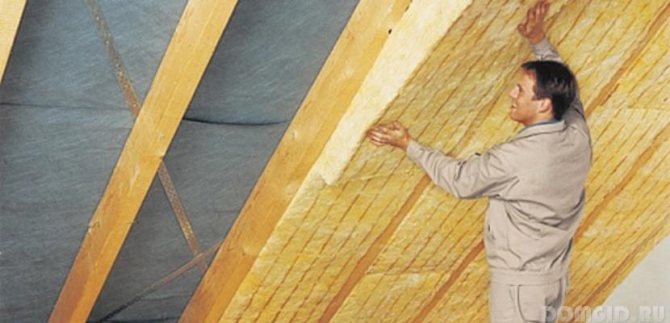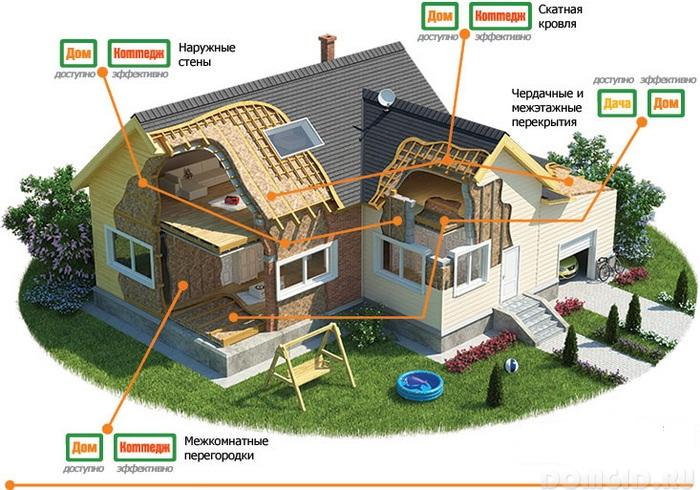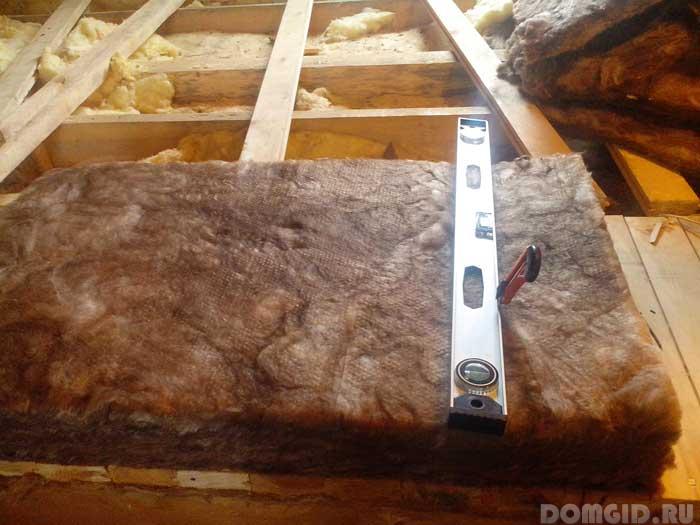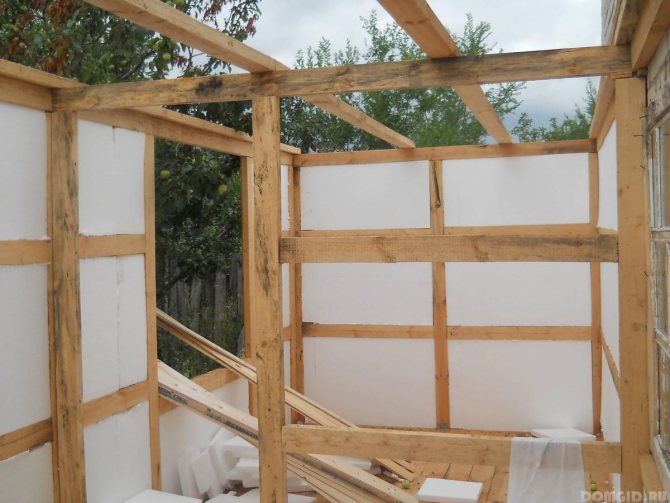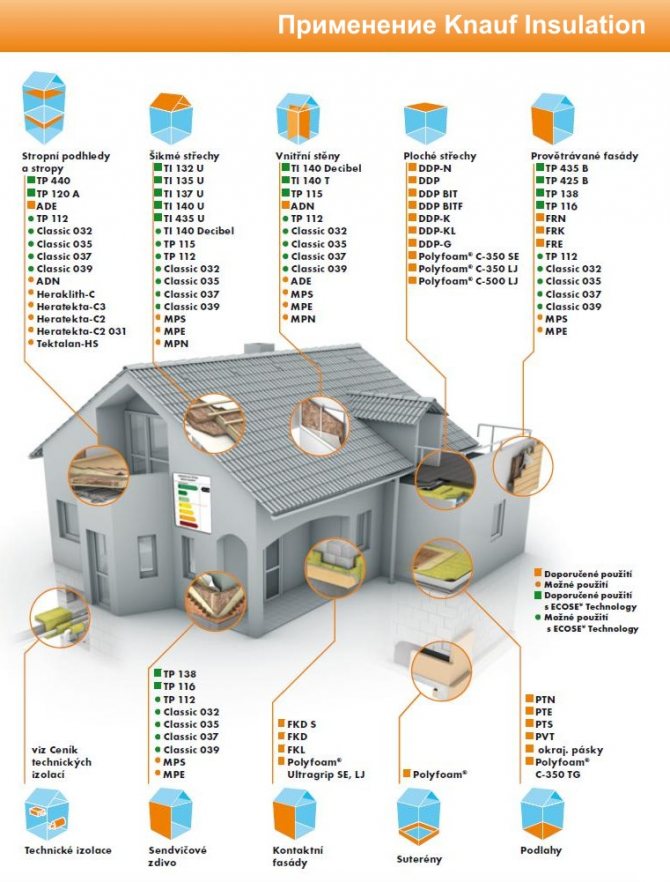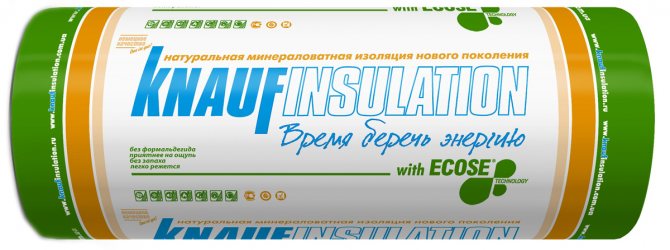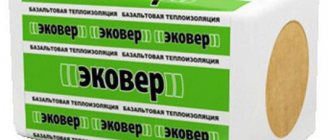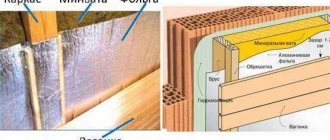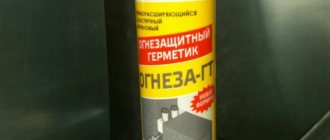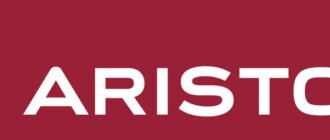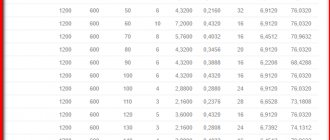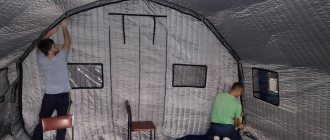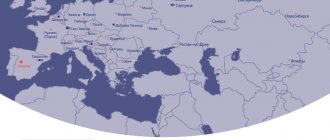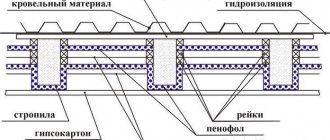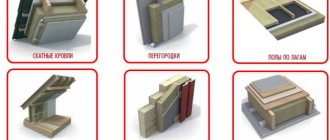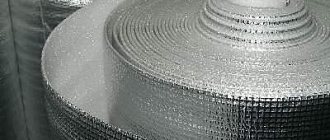The construction of an individual dwelling house, a year-round summer cottage or hunting lodge, a number of some household structures is impossible without insulation. The competent choice of this material largely determines the quality of the microclimate in the premises, the degree of their noise insulation and the rate of energy saving. One of the leading positions in the production and sale of products in this segment is occupied by the German company Knauf (Knauf).

Areas of use


The manufacturer has developed special modifications of insulation for any construction needs, differing in density, shape and size. Minvata KNAUF will find application anywhere:
- Can be used for roof insulation. (Ventilated or non-ventilated)
- Warming and sound insulation of the floor of the premises.
- Thermal insulation of the basement and basement of buildings, in order to maintain the stability of the soil in the winter.
- External and internal insulation of walls of various buildings.
- Thermal insulation of balconies, basements and loggias
- Prevention of freezing of non-residential premises, production areas and warehouses.
- Thermal insulation of air conditioning and ventilation systems.
Due to the vastness of the assortment, you can find the best option for Knauf insulation for any purpose. The main varieties of Knauf mineral wool and their properties are described below.
Advantages of Knauf heaters
- Low coefficient of thermal conductivity.
- High sound absorption coefficient.
- High fire resistance. The entire line of heaters is marked as non-combustible materials NG.
- Maximum biostability: mold does not start in heaters.
- Mineral wool insulation does not damage rodents.
- No odors from the material.
- A completely natural composition based on basalt provides hypoallergenicity.
- Convenient packaging and release form. Knauf roll insulation allows you to quickly cover large areas.
- Convenient installation and dismantling of insulation.
- Low weight of insulation: an extremely important characteristic in the logistics of the material and when working with it.
- Elasticity: the material can be compressed, it will straighten itself to its original state.
- Very long service life - up to 50 years.
- Versatility of the material: suitable for insulation and sound insulation of all structures of the house.
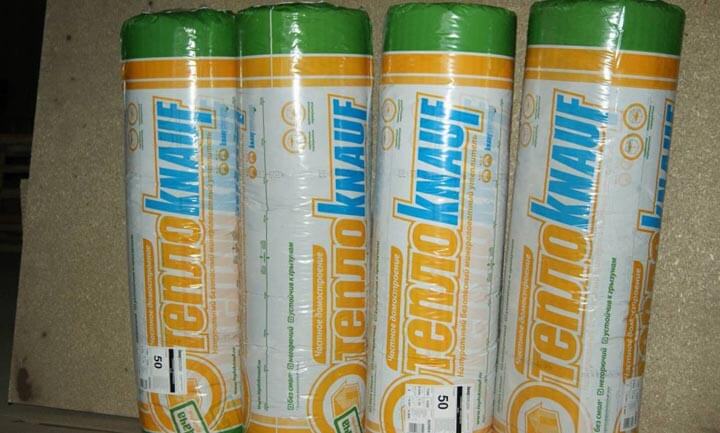

The knauf insulation rolls are warm.
Today the Knauf company produces two lines of insulation, differing in the main area of application.
- KNAUF insulation - for industrial and multi-storey construction,
- TEPLOKNAUF - for suburban construction and insulation of a summer house, cottage, private house.
Benefits of mineral slabs
For thermal insulation of a house or summer cottage, Knauf mineral plates are chosen more often than other heaters and there are good reasons for this. The material really has obvious advantages, which include:
- The minimum coefficient of thermal conductivity, which allows you to maintain an optimal microclimate in the room after insulation with a reduction in heat consumption costs.
- Excellent sound absorption performance.
- Fire resistance - Knauf mineral wool slabs belong to the group of non-combustible materials, which is especially important for the insulation of residential buildings, summer cottages and other structures.
- Light weight - the load on structures using Knauf mineral wool is minimal.
- No shrinkage - even after the expiration date (50 years), the material retains its original shape and functionality.
- Simple and quick installation - Knauf mineral wool insulation technology will be understandable even for a beginner.
- Complete environmental friendliness due to the absence of toxins and dyes in the composition of mineral wool.
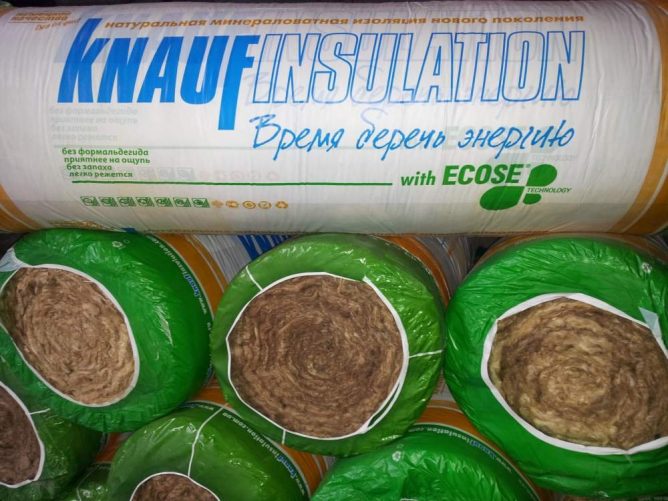

Of the minuses, one can note the higher cost of mineral slabs compared to competitive products, which, however, is justified by their high technical characteristics and long service life.
Useful properties of heaters
The produced heat insulators fully meet the requirements of consumers, providing high-quality heat saving and sound insulation.
The line of products used for thermal protection of buildings and structures includes products based on inorganic fibers and expanded polystyrene.
Knauf heaters have technical characteristics that allow them to be used for thermal insulation work on any part of the house.
Selection rules
If you are purchasing Knauf insulation for the first time, it is recommended to seek the help of experienced consultants who will help you choose this or that option, as well as calculate its quantity.
The cost of the insulation depends on the following:
- his type;
- the number of plates;
- their size;
- loads;
- places of equipment.
When choosing one or another option for insulation, consider the following:
- the thickness of the slabs - structures are needed for walls that are thinner than for the floor;
- for pitched roofs, choose products based on fiberglass or basalt;
- polystyrene foam with a water-repellent effect is best suited for the foundation.
When insulating, do not forget to provide waterproofing, vapor barrier and windproofing. To fix the insulation, be sure to use dowels or foam.
Products of the Knauf brand are much more expensive than their counterparts, but the high price is due to the excellent quality of the products and their long service life. Accordingly, you do not have to spend extra money on unnecessary repairs during the application process.
HeatKnauf in individual housing construction
Natural insulation Teploknauf Cottage and Teploknauf Cottage plus have a three-layer structure, therefore, the protection of premises occurs in three directions: from loud sounds, from humid and cold air. Thermal insulation is used to protect the surfaces of walls, ceilings and floors, roofs and attics, basements and foundations. At retail and wholesale, Knauf thermal insulation is delivered in rolls or in plates with a canvas (plate) thickness of 50 mm, a length of 1230 mm and a product width of 610 mm. The rolled heat knauf has a length of 6148 mm and a width of 1220 mm. Insulation "TeploKNAUF Cottage +" is produced only in the form of plates with a thickness of 100 mm with other parameters similar to the parameters of heat-knauf insulation.
| Technical specifications | Plates Cottage plus Knauf | Rolls Cottage Plus | Cottage plus in slabs |
| Thermal conductivity index at + 100C, W / m • C | 0,037 | ||
| Sound insulation index С111, RW (W) | 45,0 | ||
| Flammability of insulation rolls and plates | NG Group | ||
| Length in mm | 1230,0 | 6148,0 | 1230,0 |
| Width | 610,0 | 1220,0 | 610,0 |
| Thickness | 50,0 | 50,0 | 100,0 |
| Package volume, in cubic meters | 0,75 | 0,75 | 0,6 |
| Total container area, in square meters | 15,0 | 15,0 | 6,0 |
| Units in a container | 20,0 | 2,0 | 8,0 |
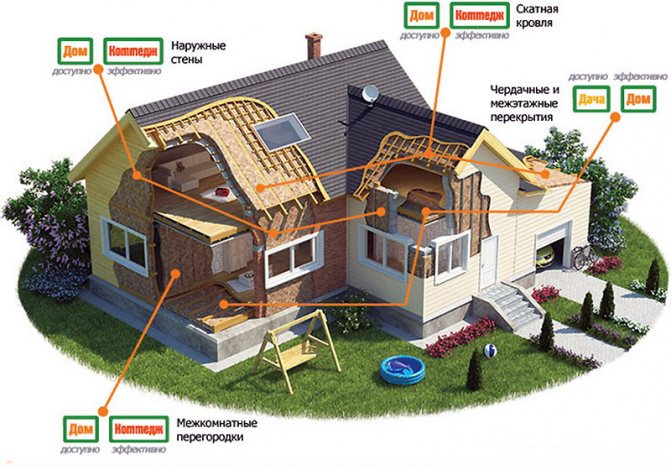

Scope of thermal insulation TeploKNAUF Cottage +
Thermal insulation HeatKNAUF House and HeatKNAUF House +
The multidisciplinary insulation of the Teploknauf House is produced according to the innovative technology "3D-elasticity", and the impressive parameters of this insulation material are shown in the table below. The ability of insulation to adhere so tightly to the surface to be insulated does not give the slightest opportunity to appear "cold bridges". The advantage of the TeploKNAUF House material, which is made twice as thick (not 50, but 100 mm), is in saving thermal insulation on any surfaces. The product is produced in the form of slabs and rolls.
| Technical properties | Teploknauf House | Teploknauf House Plus |
| Thermal conductivity index at + 100C, W / m • C | 0,040 | |
| Noise insulation index С111, RW (W) | 45,0 | |
| Flammability of heat insulators in slabs and rolls | NG Group | |
| Length in mm | 1230,0 | 6148,0 |
| Width | 610,0 | 1220,0 |
| Thickness | 50,0 | 100,0 |
| Package volume, in cubic meters | 0,6 | 0,6 |
| Total container area, in square meters | 12,0 | 6,0 |
| Units in a container | 16,0 | 8,0 |
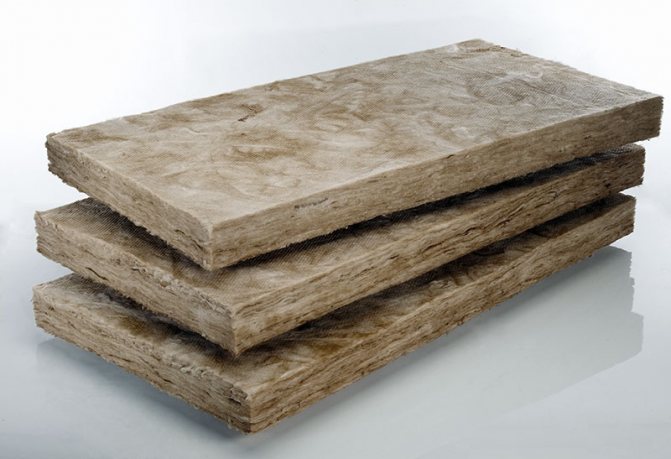

Thermal insulation TeploKNAUF House +
Teploknauf Dacha
This insulation material is produced in rolls, which makes it possible to insulate large areas more conveniently and much faster, for example, the ceiling in the attic or roof surfaces, interfloor ceilings and floors in the basement. In individual construction, it is often used to insulate outbuildings and superstructures - sheds, attics, verandas, terraces, pavilions, etc.
| Technical specifications | Teploknauf Dacha |
| Thermal conductivity index at + 100C, W / m • C | 0,044 |
| Noise insulation index С111, RW (W) | 45,0 |
| Flammability of a heat insulator in any form | NG group (non-combustible material) |
| Length in mm | 7380,0 |
| Width | 1220,0 |
| Thickness | 50,0 |
| Package volume, in cubic meters | 0,9 |
| Total container area, in square meters | 18,0 |
| Units in a container | 2,0 |
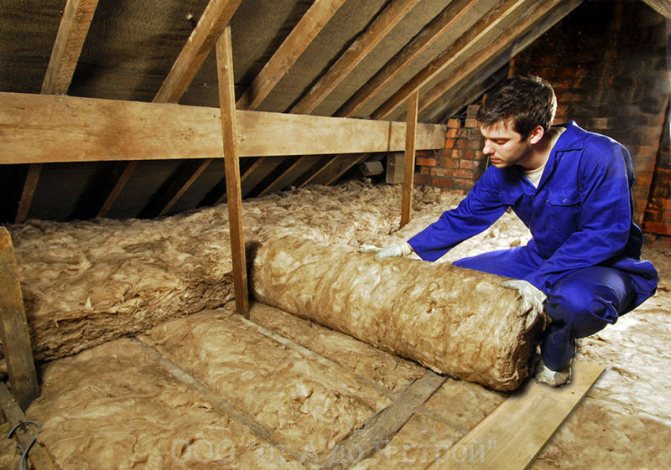

Thermal insulation Teploknauf Summer cottage
KNAUF Insulation insulation
Knauf Insulation Thermo Cooker-037. From the name it is clear that this insulation is produced in slabs, a description of the characteristics of the material is given below. Insulation is designed to protect pitched roofing surfaces, walls, ceilings, log floors, partitions, inclined surfaces of internal structures of the house. In addition to high performance in terms of thermal insulation, Thermo Plate-037 deters noise well. For fixing the slabs, a metal, wooden frame or a closed space is used, for example, between beams or lags of partitions.
| Technical properties | Knauf Insulation Thermo Cooker-037 |
| Thermal conductivity index at + 100C, W / m • C | 0,038 |
| Density Knauf Insulation | 15 kg / m3 |
| Flammability Knauf Insulation | NG group (non-combustible material) |
| Length in mm | 1250,0 |
| Slab width | 600,0 |
| Thickness of slabs | 50.0 and 100.0 |
| Package volume, in cubic meters | 0,9 |
| Total container area, in square meters | 9.0 and 18.0 |
| Units in a container | 12.0 and 24.0 |
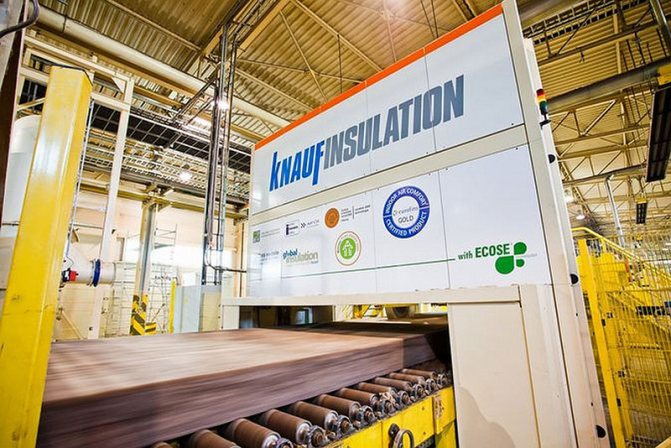

Knauf Insulation Production
TeploKnauf - a line of heaters for private housing construction
For the construction of low-rise residential buildings and a number of outbuildings, Knauf has released a line of TeploKnauf heaters. They have various purposes, sizes and some technical characteristics. At the same time, they are united by the presence of an effective water-repellent impregnation, minimum service life of 50 years and lightness.
HeatKnauf for roof and exterior wall insulation
Heat loss through the roof and outside walls can be quite high. To prevent them, Knauf offers several insulation options.
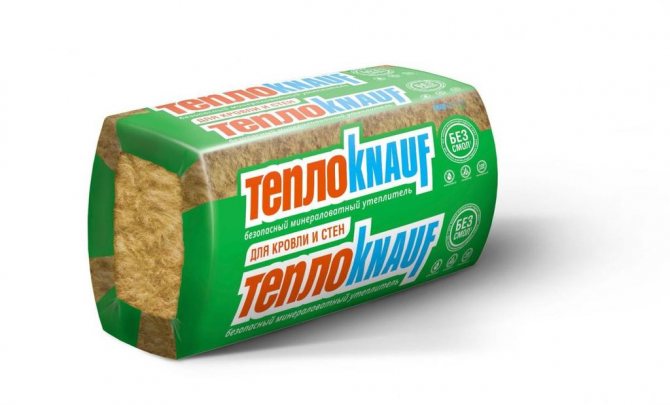

Thus, TeploKnauf for Cottage is suitable for insulating pitched roofs and exterior walls. In this case, mineral wool is represented by slabs 50 and 100 mm thick. With a length of 1 230 mm and a width of 610 mm, they are easy to use even for non-professionals, which is confirmed by numerous consumer reviews.
There is also TeploKnauf for Cottages in the "mini" format... These are slabs for walls and roofs with a thickness of 50 mm and a length of 1,000 mm. They are packed twice as compact as the standard version, so they are easier to transport.
Useful: Finishing chipboard: technology and scope
With the help of Knauf Cottage you can insulate:
- external walls of frame buildings;
- walls for ventilated facades;
- facade for facing with bricks or siding.
A separate position is occupied by TeploKnauf for Roofing. This is a roll insulation 50 or 150 mm thick. The roll length is 6,148 and 5,500 mm, respectively.
HeatKnauf for slabs - one solution for heat and sound insulation
High-quality insulation of the floor, ceiling and attic floor plays no less a role in the formation of the internal microclimate than the insulation of the outer walls. It provides not only good heat saving, but also effective sound absorption.
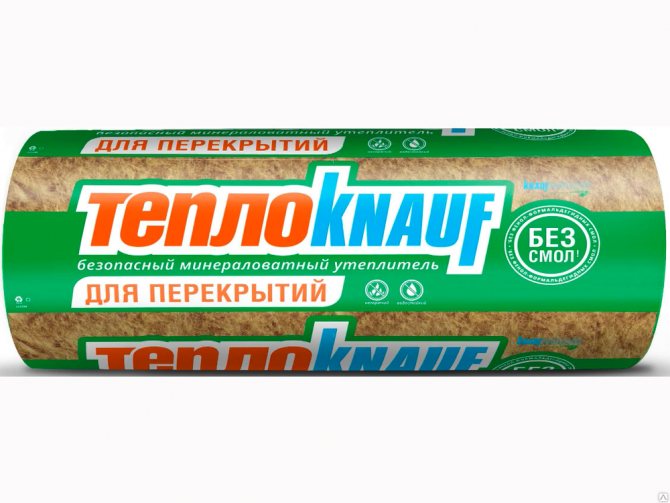

For the relevant work, the manufacturer offers the consumer TeploKnauf for Ceiling. It is suitable for insulating both timber and concrete structures. The thickness of the rolled mineral wool is 50 or 100 mm.For this reason, it perfectly complements the TeploKnauf Cottage. The rolls are 7,380 mm long and 1,220 mm wide.
Also thermal insulation "For Overlaps" is presented in a mini-format. These are rolls 50 mm thick and only 60 cm wide. They are compactly rolled up, so they take up little space even in a passenger car.
Since when working with ceilings, not only insulation is important, but also providing increased noise absorption, it is worth paying attention to sister product of the company - AcustiKnauf... Its production is also based on Ecose technology.
The improved sound insulation effect is achieved by the long and extra thin mineral wool fibers. Knauf Acoustic is suitable for acoustic floors, false ceilings and partition insulation.
Other HeatKnauf Products
In the line of insulation TeploKnauf there are products “not for everyone”. We are talking about TeploKnauf Nord - an insulating material for regions with extremely harsh winters. Its features are the integrity of the thermomat (one layer), the increased number of fibers and their increased elasticity.
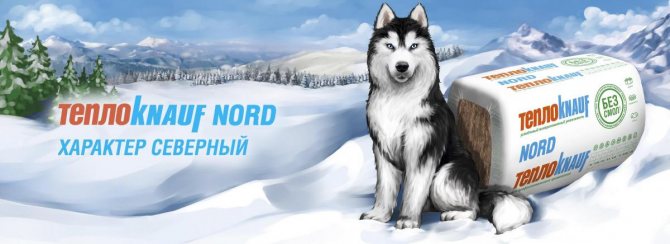

As a result, Nord insulation:
- 15% warmer than a standard Overlap Thermomat;
- 40% more elastic in comparison with the main line of TeploKnauf;
- 10% more moisture resistant.
The thickness of Nordic mineral wool is 50 mm. This makes it versatile, suitable for insulation of roofs, ceilings, walls, floors.
A number of products have been discontinued, which is indicated on the official website of the company. However, sometimes they can be found among the leftovers in some hardware stores:
- HeatKnauf Premium. Differs in increased strength, resistance to deformation.
- HeatKnauf Home and Home +. Elastic slab material, suitable for insulation of ceilings, walls, roofs.
- Knauf Dacha is a budgetary roll insulation 50 mm thick for country houses, outbuildings in garden plots.
- Knauf Expert is an affordable solution designed specifically for DIY stores.
- Knauf ECOroll (Knauf Ekoroll). A budget option for horizontal surfaces.
The TeploKnauf product line is quite large, so choosing the best option is not difficult.
Useful: Ecover: insulation for a wide range of buyers
Heaters HeatKnauf
There are several varieties of Teploknauf heaters. Each of them is designed for its own type of building, differs in thermal insulation properties and, of course, in price.
Knauf Cottage
In addition to heat-insulating, it is distinguished by high sound-proof and waterproofing properties. It is a versatile material that can provide thermal insulation for both roofs and walls.
It is mainly used for country houses. It is produced in the form of slabs with a thickness of 50 mm.
Knauf Cottage +
These heaters have technical characteristics similar to the previous type, however, the thickness of the plates is 2 times greater, which makes the production of insulation works in cold areas more economical and faster (it is cheaper and easier to mount one thick layer than two thin ones).
Knauf Dacha
A relatively inexpensive version of insulation designed for buildings with periodic presence of people - for example, summer cottages, sheds or summer kitchens.
In severe frost, such products are ineffective.
Knauf House
The improved technical characteristics of these materials make it possible to use them to improve the thermal insulation properties of both private houses and apartments. The thickness of the slabs is 50 mm.
Knauf House +
The properties are the same as those of "Knauf Dom", but the thickness is already 100 mm, due to which the materials are more profitable to use in areas with lower average annual temperatures.
Knauf and its products
Industrial group Knauf works since 1932 and all these years she specialized in the production of goods for the construction and renovation. A significant amount in the range of materials for construction in the German company is occupied by mineral wool insulation.
For buyers, they are no longer a novelty, many have repeatedly managed to appreciate the quality of heaters from the German manufacturer Knauf. In addition to builders, they are also highly regarded by construction experts. Knauf thermal insulation is sold all over the world, the products are not only of high quality, but also safe for health.
Thermal insulation boards and mats based on mineral wool are very popular with builders. All materials are produced using innovative methods. Modern production technologies help to make Knauf heaters highly effective and safe for people. Assortment of products is constantly expanding, they can be classified according to several criteria.
The basis of Knauf heaters is basalt wool and glass wool with various additives. Finished products can have different shapes - rolls, in the form of slabs, filled and sprayed. The material also differs in its purpose - for home, summer cottages and cottages. It is used to insulate horizontal surfaces, facades and roofs. There are several types of Knauf heaters designed for different buildings, for winter time - TeploKnauf house and TeploKnauf house +, TeploKnauf cottage, TeploKnauf dacha.
All of the listed materials differ in thickness and certain indicators of heat capacity, for example, for a house they are maximum. The choice of insulation should always depend on its purpose.
Knauf Insulation Expert Series
Heat-insulating materials "Knauf" of the Insulation series have improved strength, sound and heat-insulating parameters, and are used for the same purposes as TeploKnauf.
However, their assortment is much wider.
Thermo Plate 037
Excellent heat insulators, available in the form of slabs with an area of 0.75 sq. m. Designed for insulation of any enclosing structures - from roofs to floors on logs.
Thermo Roll 040
Suitable for thermal insulation of horizontal surfaces with a low load - floor slabs, roofs and log floors above the ground or basement. The form of release is a mat (roll or roll) with a size of 1.2 × 10 m, due to which the material is easily rolled up, transported and stored.
Insulation Pitched roof
Produced in rolls or in the form of slabs, materials with high waterproofing properties, due to which they do not absorb moisture at all. With their help, pitched roofs of residential, industrial and office premises are insulated. There are the following main varieties of this type of Knauf insulation:
- mats Thermo Roll 037A having a length of 5.5 and 9 m and a width of 1.2 m;
- plates Thermo Plate 037A and 034A with dimensions of 0.61 × 1.25 m;
- Thermo Roll 034A, with width and length, respectively, 1.2 and 5.0 m.
Facade
This type of insulation of the Insulation Expert series does not absorb moisture thanks to Aquastatik technology and may well be used not only for interior, but also for exterior decoration. It is produced in two modifications, 032A and 034A, differing in thermal conductivity, but the same size - 0.6 × 1.25 m. The thickness of the slabs is from 50 to 100 mm.
The thermal conductivity coefficients of all these Knauf materials are easily determined from the number in the brand name - for example, 037 means an indicator equal to 0.037 W / m2 • K. The figure 040 indicates the value of the coefficient equal to 0.04 W / m2 • K. And the standard thickness of the slabs is 0.05 and 0.1 m, except for the option for a pitched roof Roll 037A, the thickness of which can be 0.15 m.
Knauf Ekoroll
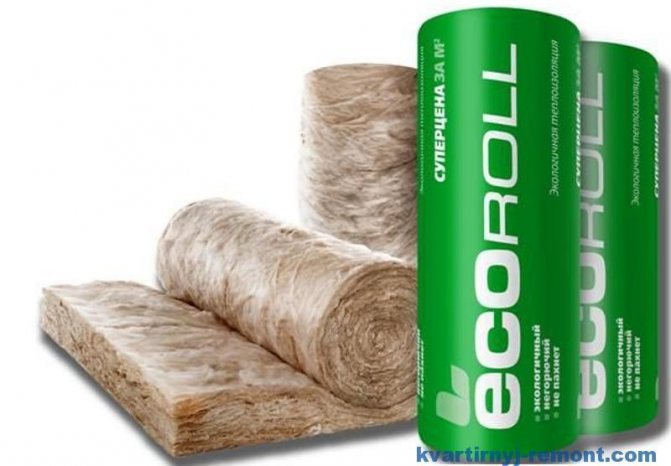

This brand of roll insulation meets all of the above characteristics - high heat and sound insulation, 3D elasticity technology, environmental friendliness, fire resistance and protection from rodents. Mineral fiber in the composition of the product is characterized by high vapor permeability, which allows the house to "breathe" and maintain a comfortable indoor microclimate.
Minvata Knauf Ekoroll is recommended mainly for thermal insulation of horizontal structures.
It is made in the form of large-volume rolls, in the KNAUF product line it is one of the most budgetary options. The size of a regular roll is 8.2 mx 1.22 m. The minvat in a roll is compressed in such a way that when unpacked it increases in volume almost 6 times. Soft and easy to use, this cotton wool is used in structures that are not subject to stress - with its help they insulate and soundproof:
- frame houses;
- pitched roofs;
- attic;
- overlapping between floors;
- interior partitions;
- floors on logs.
This affordable material is almost universal when insulating a residential building. Its density is slightly lower than that of other Knauf products - 10.5 kg / m3. A large area of insulation in a roll allows it to be laid with a minimum number of joints, which significantly reduces heat loss.
Knauf Insulation - heaters for professionals
If the TeploKnauf line of insulation was developed for independent home insulation, and working with them did not require any special professional skills, abilities, knowledge, and tools, then the professional line of Knauf Insulation insulation is professional quality materials for multi-storey construction and they are focused on industrial and social construction.
A feature of the line is the division of heaters by purpose:
- For facade insulation.
- For roof insulation.
- For soundproofing.
The scope of application is due to the specifics of technical characteristics and installation features. The KNAUF Insulation dimension ruler is wider: 50 mm, 70 mm and 100 mm in thickness.
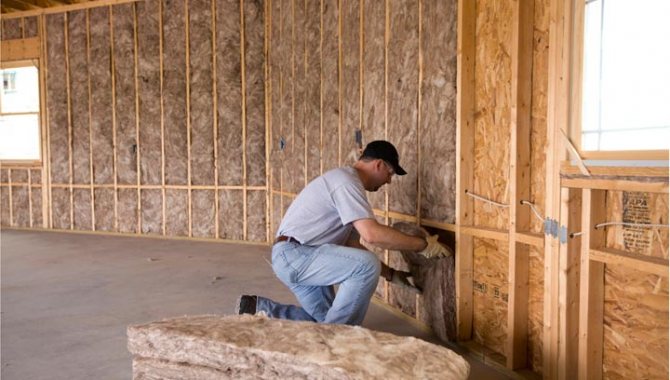

Do-it-yourself frame insulation.
Facade KNAUF Insulation
The material was developed to insulate external walls from any material and erected using any technology. Knauf insulation insulation is perfect for insulating buildings made of bricks, blocks, concrete slabs, houses erected using frame technology.
Today knauf insulation for facade systems is produced in two slightly different variations: ThermoPlita 034A and ThermoPlita 032A. They differ primarily in density, and as a consequence - in the quantity and volume in the package.
Knauf facade insulation for walls is mounted between two layers of the wall - internal and external, it is often used to create ventilated facades, as well as when sheathing a house with siding systems. Special impregnation with water-repellent compounds ensures that the insulation does not lose its properties when it comes into contact with atmospheric moisture.
KNAUF Facade allows to reduce heating costs of buildings by 2 or more times.
On a note. The Knauf Insulation façade is optimally suited for industrial construction, as well as for wall insulation of social infrastructure facilities. It is often used as the main insulation for agricultural buildings, where it is planned to keep animals year-round.
Knauf Ekoroll
Separately, it should be said about the material for horizontal surfaces. Knauf Ekoroll insulation is designed just for warming and soundproofing floors and ceilings on logs. A feature of the insulation is high vapor permeability, which ensures correct vapor and air exchange in the room and guarantees not only comfort to residents, but also protection from moisture and mold.
KNAUF EKOROLL is very popular in the construction of houses using frame technology.
Pitched roof KNAUF Insulation
A special development of the KNAUF company will allow you to easily insulate a pitched roof. The features of the material are a convenient form of release, which allows you to quickly mount the insulation on inclined surfaces, as well as high-quality impregnation with Aquastatic water-repellent compounds.
Insulation of the roof with material KNAUF Insulation pitched roof will not only protect the house from freezing in winter, but also provide a comfortable indoor temperature in the summer heat, and also soundproof the premises of the wasps on the side of the roof.
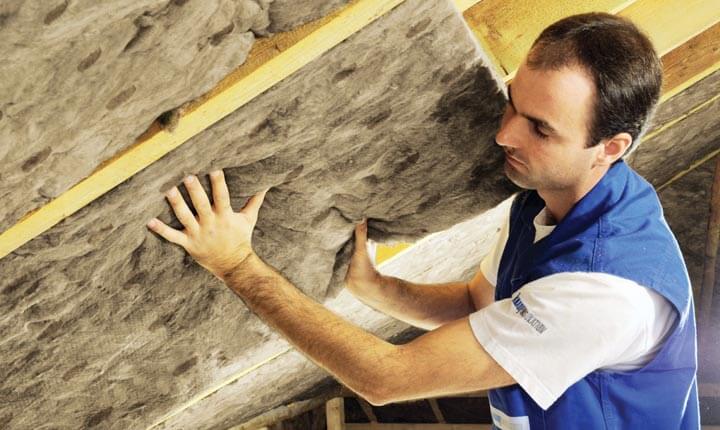

Knauf for roof insulation.
The KNAUF Insulation pitched roof is a solution for those buildings where the upper floor is an attic, and iron or metal tiles were chosen as the roofing material. The material will absorb unwanted sounds inevitably caused by rain.
In addition to Knauf roofing systems, roofing insulation is popular for floor insulation on logs on the ground floors and in attics.
The KNAUF Insulation pitched roof is available in two sizes for a thickness of 100 and 50 mm and in two types of slab and roll, which allows you to select the material so that the minimum amount of trimmings remains during installation.
Acoustic partition KNAUF Insulation
Special technology for the production of mineral basalt wool Knauf Insulation Acoustic partition allows you to maximize the sound-insulating properties of the material. The special shape and structure of the fibers reliably isolate the premises from noise.
The material is optimal for insulating buildings located at traffic intersections, next to highways, railways, tram depots. Also, the use of the KNAUF Insulation Acoustic Partition is justified when organizing leisure places with an increased noise effect on the first floors of residential buildings - bars, restaurants, disco cafes, cinemas.
Professionals recommend using Knauf Acoustic insulation in the construction of hospitals, kindergartens, schools, soundproofing production facilities with this material.
On a note. The professional characteristics of the KNAUF Insulation Acoustic Partition will allow you to be 100% soundproof from annoying neighbors with their noisy parties or screaming children.
The KNAUF Insulation acoustic partition is available in slabs and mats in rolls.
Today Knauf heaters are recognized as leaders in their segment. They provide excellent thermal insulation performance for all regions of Russia. You can now watch the technology and process of warming a country house or summer cottage with a roll or sheet KNAUF insulation from numerous videos on the Internet. Working with mineral basalt wool does not present any difficulties and does not require special preparation or tools.
The availability of Knauf heaters is unprecedented today. Any hardware store will offer you at least 5 types of products of this brand, and the rest will be easy with good volumes to order. Wholesalers and official representatives of the company are ready to work even with small wholesale and usually offer the entire line of heaters.
Knauf insulation has only positive reviews from both private craftsmen and construction companies. The only gripe is the rather high price of the insulation, however, the quality is worth it!
Installation features
Preparation of the frame for external wall insulation
When installing mineral wool of the Knauf Cottage brand, it is necessary to follow the manufacturer's recommendations and basic rules so that the result is as ideal as possible. The installation process consists of several stages and includes the installation of the frame, the insulation itself, as well as the application of a vapor barrier film. You can cope with this process on your own if you have skills in the field of construction and finishing work, or entrust the installation to professionals.
Frame
The primary timber frame is required for the direct installation of the insulation on the walls. Without it, the material will not hold. Before installation, the walls are cleaned of unnecessary elements and wood bars are prepared, which are treated with a refractory compound. They are fixed horizontally and vertically on the walls from one corner to another; in the presence of irregularities, special substrates are made from various materials.
The bars are fixed with self-tapping screws 75 mm, each fastener is installed at a distance of at least 40 cm from each other. After installing the first beam, you need to measure 58 cm from it, since the width of the slab is 61 cm, then the second and subsequent beams are fixed in compliance with this distance. The windows are framed with bars horizontally and vertically, taking into account the plane of the wall.
If necessary, you can use additional substrates that allow you to level the surface of the walls and fix all the beams with slabs as reliably as possible.
Insulation installation
Insulation installation
Plates are installed, starting from the corner, they are slightly squeezed and placed between the beams, then fixed on the wall using special fungi. For one plate, you will need at least 3-5 fungi, taking into account the material in one package, each of them is mounted in a through hole with a diameter of at least 6 mm, made with a perforator or drill. The insulation can be cut to fit the spacers using a paint knife. After filling all the cells between the bars, proceed to the installation of the film.
Installation of vapor barrier film
Mansard roof vapor barrier
The film is necessary to prevent the formation of condensation inside the insulation; if it is present, steam particles simply go outside towards the cold air. It must be installed with the smooth side up, taking into account the instructions, each strip is placed from the bottom up, taking into account an overlap of 10 cm or vertically from the corner. For the most reliable fixing, the film is sewn to the wood of the bars using a construction stapler. Also, the seams must be glued with double-sided tape so that they do not part. After the walls are sewn up, you can start installing the siding.
Siding
For siding, they use bars in the size of 25x50 or 25x100 mm, special self-tapping screws with a length of 35 to 55 mm and a screwdriver. Frame boards are impregnated with a bioprotective solution and cut according to the required length, which should correspond to the length of the boards for the first frame. Next, you need to form the corners and screw them to the horizontal bars on the first frame vertically, the next boards are attached at a distance of at least 25 cm from each other. Following these rules helps to make the structure more durable in addition to the standard insulation procedure.
It is important to always follow the manufacturer's recommendations and not combine materials that are incompatible with each other. In this case, the insulation does an excellent job with its direct and additional functions.
Advantages of Knauf Acoustic plates
The main advantage of the material is its ability to absorb various types of sounds and noises. The soft base captures and absorbs sounds as efficiently as possible. Thin fibers provide good air and steam permeability, which makes it possible to use insulation in rooms with high humidity. The flexible structure helps to insulate and isolate the sounds of sewage. The material can be wrapped tightly around the pipe, thereby reducing the noise of the sewer. Cotton wool can be used both for apartments and private houses. Quite often Knauf ceiling noise insulation is used as insulation for roofs, attics and attic.
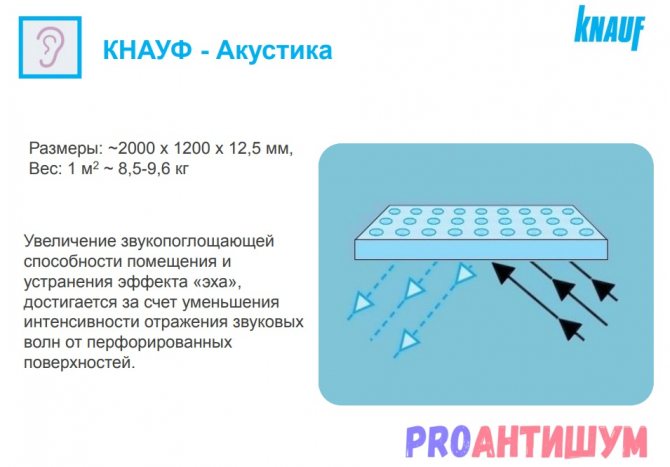

Speaking about the advantages, one cannot fail to note the environmental friendliness of the material. The product is made from natural raw materials, so there are no harmful elements and resins in its composition. Knauf soundproofing walls are odorless, so they are often used in soundproofing residential buildings and public premises.
It is easy and convenient to work with the material. Given the low weight of the material, it does not require special equipment for loading and transportation. One package contains 16 slabs with dimensions 1250 * 610 * 50 mm. This number of slabs is enough to cover an area of twelve square meters. To work with slabs, you do not need special equipment or tools, the laying technology is similar to those used when installing basalt or mineral wool.


Knauf soundproofing of the ceiling is carried out using a structure made of aluminum profiles or wooden beams. Due to the parameters of the slabs, the frame base is erected according to generally accepted dimensions with a step width of 60 centimeters.The slabs have the same width, which makes it possible to use sound insulation practically without waste.
Distinctive features
The main distinguishing feature of Knauf acoustic materials is the high quality of products. The production of mats is based on German technology using exclusively high quality equipment. In the aggregate, an ideal soundproofing material is obtained, which has all the necessary qualities and features.
If we compare KNAUF mats, it is important to note that the product has a relatively low cost, which is especially pleasant for a grand renovation. Of course, when comparing cotton wool and gypsum-based boards, the differences will be significant. First, the composition of the material differs. Secondly, a frame is not required for its installation. In addition, the panels can be used as a leveling surface. The sound insulation thickness does not exceed five centimeters, which is ideal for working with small rooms.
Knauf thermal insulation - what distinguishes it from other brands
One of the divisions of the company - Knauf Insulation (Knauf Insulation) is engaged in the production of insulation. It was his employees who developed the innovative Ecorse technology, which allows the production of environmentally friendly and safe insulation material.
Its main difference from competitors is the use of natural ingredients in the manufacture. The binder raw material does not contain phenol-formaldehydes, and the finished Knauf insulation is odorless. This means that it is safe for both humans and the environment.
In addition, the thermal insulation material has the following advantages:
- Does not support the combustion process, being resistant to high temperatures.
- Does not form a favorable environment for the development of molds and other harmful microorganisms. Not attractive to rodents.
- Convenient in work, as it practically does not get dusty, it is well cut.
- It is characterized by a high degree of elasticity, well recovering its shape after compression.
The disadvantages of Knauf insulation can be attributed, perhaps, only to its price. Sometimes it is almost an order of magnitude higher than that of economy class brands.
Layer-by-layer insulation
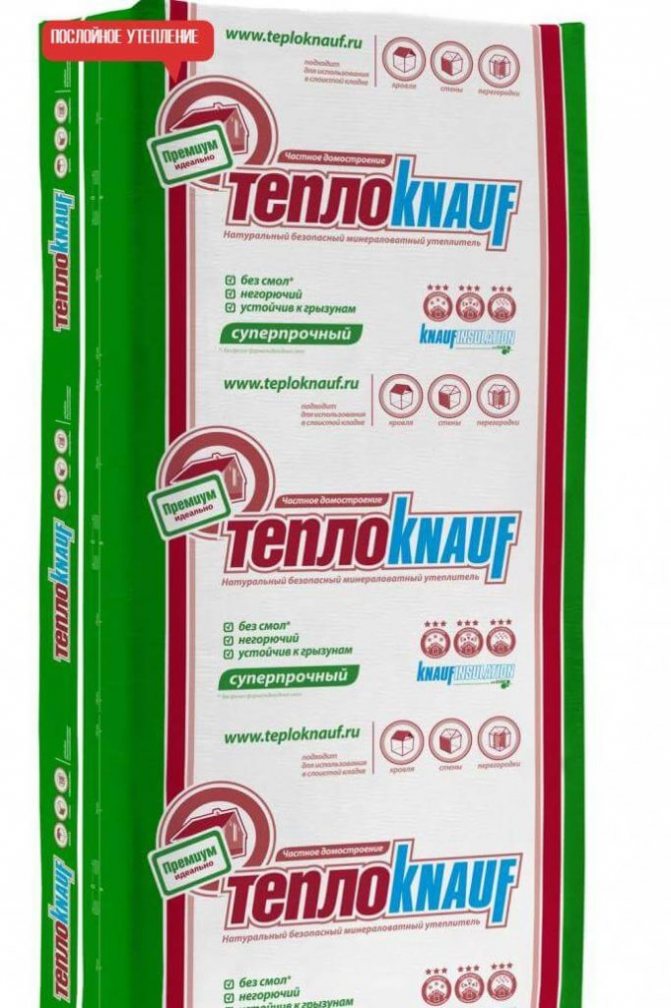

TeploKnauf Premium is the first material developed for use in private households. Does not contain fiberglass. During operation, it does not change its size, does not shrink, which avoids tears in the insulation layer.
Possesses increased heat retention capacity, good sound insulation. Resistant to getting wet. It is used for insulation of enclosing structures, including for layered wall masonry. The minplate has dimensions of 1230x610 mm.
If you need it only for yourself
For ease of use and transportation, TeploKnauf House Mini is produced. The length of the slab is 1 m. Glass wool is not used in production. The main purpose of Knauf House Mini is to insulate enclosing structures of small area or even part of them.
Technical characteristics of mineral wool "Acoustic"
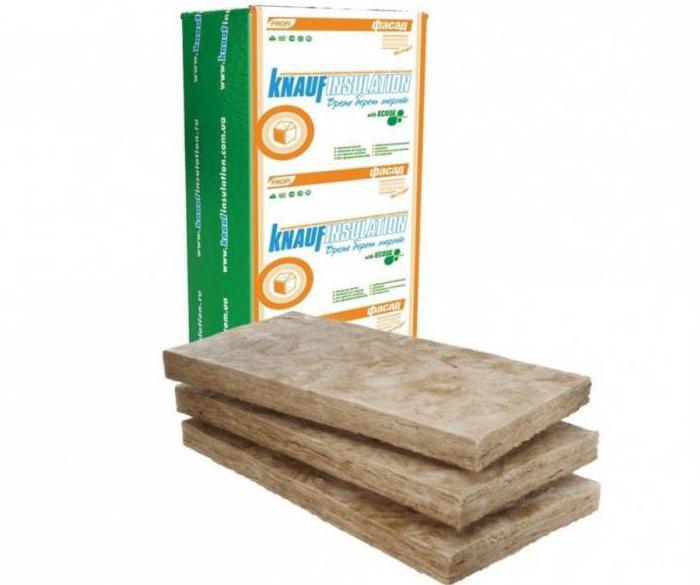

View gallery
This mineral wool "Knauf", the price of which is 1600 rubles. per cubic meter, used for thermal insulation of communications. The material is flexible enough to ensure a snug fit and exclude the formation of cold bridges. Mineral wool "Acoustic Knauf" is able to maintain its original shape for a long time, which guarantees a high level of sound insulation.
This material is characterized by an increased level of elasticity. This allows the level of impact and sound noise to be reduced by up to 1.5 times. The installation of this thermal insulation can be carried out in ceilings and partitions, as well as in suspended ceilings.
For professional use
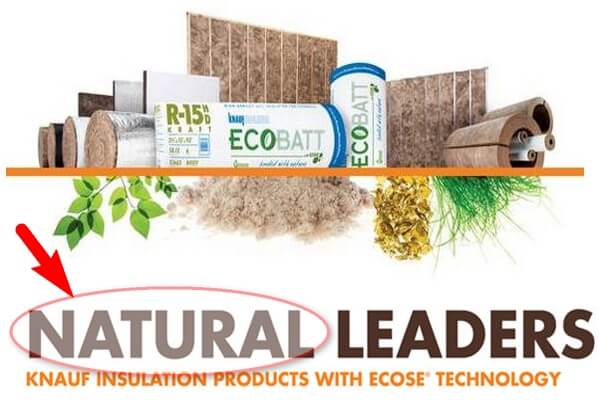

The use of Knauf Insulation insulation gives excellent thermal insulation results, regardless of who is installing it: a professional builder or the owner of the house.
The range of manufactured products allows you to select the material required for a specific case.
Knauf Insulation insulation for its environmental friendliness is recommended for use in residential buildings, preschool, school, medical and medical institutions.
ECOSE technology improves usability and comfort of use:
- more rigidity,
- better elasticity;
- less dust;
- worse moisture absorption.
Thermal insulation is produced under the following brands:
- Knauf Insulation Thermoplite for thermal insulation of vertical structures and roofs with a slope.
- Knauf Insulation Thermo Roll (TeploKnauf Ekoroll) for thermal insulation of horizontal surfaces. It is best to use Knauf for no-load slabs.
- Knauf Insulation Pitched roof for thermal insulation of buildings of any purpose.
- Knauf Insulation Facade to prevent heat loss through walls as a middle layer with cladding.
Monolithic heaters
- Thermo plate is made from expanded polystyrene. Thanks to the extrusion process, it acquires such a property as thermal insulation. The numerical indicator of specific thermal conductivity is one of the lowest among heaters and is at the level of 0.04 W / m2 K.
- Knauf Therm expanded polystyrene can operate for more than 50 years if the operating conditions are observed.
- The thermo plate is destroyed by direct sunlight. It has extremely low chemical resistance to acids, solvents, and petroleum products. Therefore, the insulating outer layer on the walls must be protected with plaster or siding.
- She has complete biological passivity. Does not spread fungus, mold, bacteria on its surface. Not used for food by rodents and insects. Therefore, it is better to insulate the roof from the inside with the help of polystyrene foam materials.
- The thermo plate has a high density, which makes it an irreplaceable sound insulator of enclosing structures.
- Its fire hazard is high enough. When exposed to an open fire, the thermo plate ignites, maintains combustion, and releases substances harmful to breathing into the atmosphere.
- When used in the required conditions, the thermo plate is absolutely environmentally friendly. It does not smell, does not emit harmful substances, does not collapse.
New development
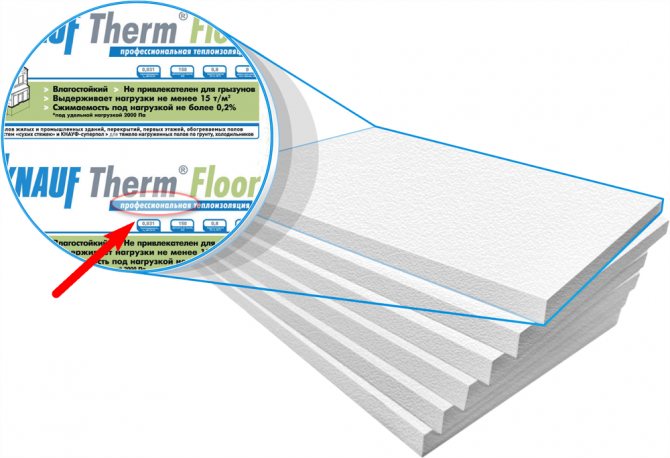

Monolithic materials are used for thermal protection of houses, summer cottages, walls, facades, roofs, floors, foundations.
The newly developed Knauf Therm Floor is a durable material for insulating plinths, foundations, blind areas with a load of up to 12 tons per m2. Polyfoam Flor has moisture absorption up to 0.8% of the volume of the insulation. It is used in the arrangement of "warm floor" systems.
If you need an effective, comfortable, innovative material to protect your home from heat loss and noise penetration, choose Knauf products. It meets all the declared characteristics and will help you forget about the cold and noise in the house for a long time.
Specifications


View gallery
The thermal insulation described in the article quite easily copes with the effects of temperature changes. It does not burn or deform irrevocably. If you decide to purchase this thermal insulation, you should inquire about thermal conductivity. For mineral wool, this parameter varies from 0.035 to 0.4 W / m. This indicates a low level of heat transfer. As practice shows, cotton wool does not transfer heat. She cannot cope except with thermal radiation, however, other heaters can be used for this, which can be combined with mineral wool.
Minvata "Knauf", the characteristics of which you must study before purchasing this insulation, has a low water absorption. The amount of water from the total volume can be approximately 2%. If we translate this value into simple language, then after the plate has been in water for several days, it will absorb only a few percent of the liquid, compared to the total volume of the material. This indicator is insignificant, which made it possible for the mineral wool to stand on a par with the foam. With all this, the thermal insulation remains vapor-permeable.
Minvata "Knauf", the technical characteristics of which are presented in the article, does not burn and does not heat up. It can only get charred, but only when exposed to direct fire. It is also important to pay attention to the density. This parameter can be different. Several varieties of branded insulation are on sale.

